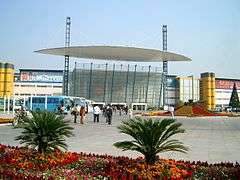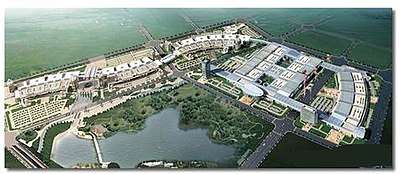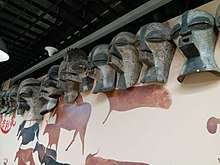Yiwu International Trade City
| Yiwu International Trade City | |
|---|---|
 Yiwu Market | |
 Location within China | |
| Alternative names |
• Yiwu Futian Market • China Commodity City |
| General information | |
| Type | Shopping mall |
| Location | Yiwu, Zhejiang, China |
| Coordinates | 29°20′23″N 120°06′40″E / 29.33972°N 120.11111°ECoordinates: 29°20′23″N 120°06′40″E / 29.33972°N 120.11111°E |
| Inaugurated | 22 October 2002[1] |
| Owner | Yiwu Municipal Government |
| Technical details | |
| Floor count | 5 |
| Floor area | 5,500,000 m2 (59,000,000 sq ft)[2] |
| Other information | |
| Number of stores | 75,000+[2] |
| Website | |
| http://yiwu.expopromoter.com/en/13453/ | |

Yiwu International Trade City is the primary wholesale market complex in Yiwu, Zhejiang. There are a number of other large wholesale markets in Yiwu including the Huangyuan Market for clothing, several furniture markets, a capital goods market, and others.
It's the world's largest wholesale market for items that are "relatively inexpensive, non-technical, mass-market", serving as the major conduit for many types of such goods.[3][4]
History
Yiwu is a hilly region originally inhabited by farmers. Poverty-ridden land left peasants with no option but trade for a living. As early as the 1600s, trading flowered in Yiwu.
In the 1600s Yiwu peasants started trading in chicken feathers, as they were used as a natural crop fertilizer. Using these feathers, they also made some other household articles that were attractive on the market and even started exportation. During periods in which farming did not require substantial work, farmers traveled across villages, selling sewing needles, threads, candies and other small articles. The traveling farmers selling goods grew in number and many wholesale markets came into existence to cater to them.[5]
In 1982, the local government put cement boards over a ditch near Huqingmen Street and set up around 700 stalls. It was from that first early complex that Yiwu market was born. Over the course of time, the wholesale market in Yiwu has undergone several changes.[3]
Customer base
The market is open almost every day from 9 am to 5 pm (except during the holidays of Chinese Spring Festival). The market attracts small volume buyers as the goods on offer are off the shelf products.[6] This means the products are ready made items that can be picked up by importers. In contrast importers often make orders that are manufactured by factories upon receiving an order and a down payment.[6] Adding to the market's appeal for small buyers, like discount store owners, is the ease of ordering small quantities from dozens of different stalls and shipping home all of the orders as one consignment.[4]
The market is an approach that stands in contrast to the better known Canton Fair, an exhibition held twice a year for manufacturers and buyers to conclude business deals. The difference lies not only in the Yiwu market remaining open year round but due to the small quantities available for sale.[4] Buyers are easily able to buy one or two cartons of goods, a quantity usually far too small for manufacturers to entertain at the Canton Fair.[4] A downside to the Yiwu market is a focus on mass market goods with a lack of selection in niche categories, unlike the Canton Fair.[4]
The market sees thousands of customers everyday, most of whom are Chinese. The most common foreign buyers are from the Middle East, Russia and Africa.[4] The number of buyers of the Middle East has given rise to a street filled with Middle Eastern restaurants.[4]
Layout
The market is divided into 5 districts covering an area of 4 million square meters for 75,000 booths where 100,000 suppliers exhibit 400,000 kinds of products.[3] The products come from around 40 industries and include 2,000 different categories of goods.
Given its size and the variety of booths selling different items, the market is a vast labyrinth. A photographer documenting the market told CNN: "I spent a total of four days constantly walking around Yiwu and wouldn't say I got near to seeing all of the stalls."
District 1

Initial construction of the first complex of the market began in 2001 and was opened on 22 October 2002. District 1 covers an area of 340,000 m2 (3,700,000 sq ft) hosting 9000 booths and over 10500 businesses. The complex cost ¥700 million to construct.
District 2
District 2 (F & G) opened on 22 October 2004, providing over 600,000 m2 (6,500,000 sq ft) of floor space for over 8000 booths and 10,000 businesses.
District 3/4
Work on the complex was constructed in two phases. The first phase finished in October 2008, while the second phase was completed on 21 October 2008. It covers an area of 560,000 m2 (6,000,000 sq ft) with 1,739,000 m2 (18,720,000 sq ft) of floor space within the complex. The building provides room for 14,000 booths.
District 5

On 5 May 2011, District 5 was completed at a cost of ¥1.42 billion. 5 storeys high with 2 underground storeys, it covers an area of 640,000 m2 (6,900,000 sq ft), providing space for over 7000 booths and shops.[7]
References
- ↑ "International Trade City". yiwuchina.org. 12 July 2008. Retrieved 17 July 2011.
- 1 2 Roxburgh, Helen (23 March 2017). "Welcome to Yiwu: China's testing ground for a multicultural city". The Guardian.
- 1 2 3 "No shortage of color in 'Commodity City'". CNN. March 1, 2015.
- 1 2 3 4 5 6 7 "Yiwu Guide: The Largest Wholesale Market in the World". ChineseImporting. chineseimporting.com.
- ↑ "Yiwu market history". Yiwu Market Guide. Yiwu Market Guide. 2016-11-28. Retrieved 2016-11-28.
- 1 2 "Yiwu Wholesale Markets – Your Guide to Buying Small Volumes from China". ChinaImportal.
- ↑ CNN, Benazir Wehelie, Special to. "No shortage of color in 'Commodity City' - CNN". CNN. Retrieved 2018-09-19.
Further reading
- Peter Hessler (June 2007), "China's Instant Cities", National Geographic Magazine, p. 4 , and an accompanying "Yiwu mall" video
External links
- "The Streets of China Commodity City" - Photo series of market published in the New Yorker